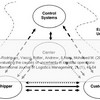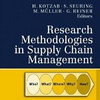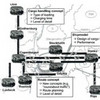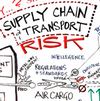 In yesterday’s post on Freight Transportations Systems Resilience I mentioned Kelly Pitera and her Master’s thesis, Interpreting Resiliency: An Examination of the Use of Resiliency Strategies within the Supply Chain and Consequences for the Freight Transportation System, where she explored and evaluated resiliency efforts currently being used by importing enterprises, focusing on goods movement within the supply chain. Today I will take a closer look at his thesis since it comes up with a novel and conceptually intriguing perspective on strategies for supply chain resilience.
In yesterday’s post on Freight Transportations Systems Resilience I mentioned Kelly Pitera and her Master’s thesis, Interpreting Resiliency: An Examination of the Use of Resiliency Strategies within the Supply Chain and Consequences for the Freight Transportation System, where she explored and evaluated resiliency efforts currently being used by importing enterprises, focusing on goods movement within the supply chain. Today I will take a closer look at his thesis since it comes up with a novel and conceptually intriguing perspective on strategies for supply chain resilience.
The research
The thesis is based on interviews with transportation and logistics personnel in 11 enterprises from the chemical, retail, food and beverage, and manufacturing industry. The respondents were asked to assess their own resilience and identify what makes them vulnerable or not, and what actions they had taken in the direction of becoming resilient.
The strategies
Based on the above interviews, Pitera identifies 15 strategies currently employed by the interviewed enterprises:
- Relationships
– building and maintaining relationships with suppliers, carriers and customers - Information and Technology
– gathering of information, primarily tracking of goods to detect anomalies - Communication
– communicating gathered information throughout the supply chain - Flexible Culture
– developing a creative and innovative business environment - Flexible Transportation
– switching transportation routes, modes and/or providers/carriers when a disruption arises - C-TPAT Certification
– compliance and full cooperation from all members of the supply chain - Structure and Size of Distribution Network
– choosing a layout that minimizes disruption impacts - Resilient Nature of Suppliers
– encourage supply partners to increase their own resilience - Expedited Freight
– using accelerated freight in case of disruptions - Use of Multiple Ports and Carriers
– reducing the locational impact of disruptions by keeping the supply chain partially intact - Employees Overseas
– overseeing and managing international operations on-site - Extra Capacity at Distribution Center
– increases the ability to hold more inventory if needed - Off-peak Deliveries
– minimizing the chance for delay or disruption due to congestion - Domestic Sourcing
– reducing disruption exposure by shortening the supply chain - Premium Transportation
– sending crucial components by transportation with a higher level of service
Pitera then divides the strategies into those that are aimed at reducing the exposure towards disruptions, and those aimed at mitigating the impact of disruptions, and discusses their advantages and shortcomings.
Pitera rightly admits that resiliency is a nebulous concept, difficult to describe in universal terms, and best understood at the individual enterprise level. Not all strategies will apply to all industries. However, as far as I see it, even with this small sample size, she still manages to capture many if not most of the strategies a company can use to address its supply chain disruptions.
Critique
Literature: In imminent danger of admitting my ignorance and throwing stones in a glass house, I have to say that the reference list appears slightly cursory. Bearing in mind though that this is a Master’s thesis, not a PhD dissertation nor a scholarly article in an academic journal, and bearing in mind that I did find to me hitherto unknown literature, I have to give her credit for a broad compilation of various articles and industry white papers.
Data selection: The enterprises were local to or with large facilities in the Puget Sound in the Pacific Northwest of the USA, so although this may appear to be a myopic view of location specific resilience, general conclusions can still be drawn, given the fact that most enterprises have a presence across the USA and even internationally.
Resilience strategies: I do have an issue with the terms flexible culture and flexible transportation. In my world, flexibility is the ability to quickly adapt to planned or anticipated sudden change of circumstances. Hence, flexibility relates to a foreseen event. The ability to quicly adapt to unplanned and unexpected sudden change of circumstances in the supply chain I would call agility. Just my two cents.
Conclusion
Master’s theses are sometimes conceptually creative, but lacking in substance and scientifically way off course. By that I mean that claims and postulations are not underpinned by references to current literature, or conversely, put forward as a contention to the current literature, but simply put forward as truths. I did not find too much of this here.
Reference
Pitera, K. (2008) Interpreting Resiliency: An Examination of the Use of Resiliency Strategies within the Supply Chain and Consequences for the Freight Transportation System. Master’s thesis, University of Washington, Seattle, WA.
Download
Author link
- linkedin.com: Kelly Pitera
Related
- husdal.com: What is Freight Transportation Resilience?












